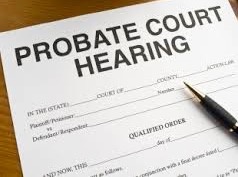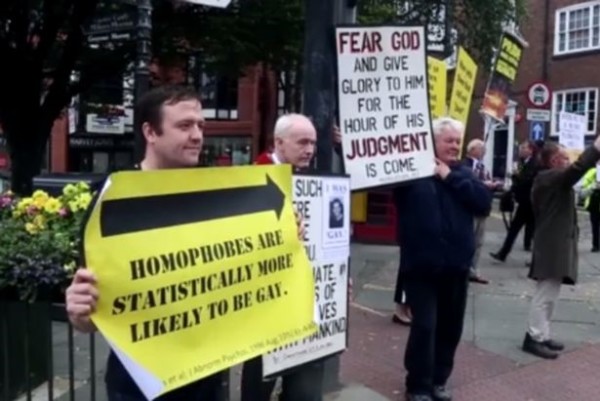Re Davies estate 2014 BCSC 1233 deals with the WESA probate rules relating to the 21 day notice and proof of delivery of that notice.
This blog will be of note to anyone applying for a grant of probate or administration as to the requirements to be met before a grant will issue.
[6] Rule 25-2(1), (2) and (3) and Rule 25-4(2) of the Supreme Court Civil Rules provide as follows:
(1) Subject to this rule, unless the court otherwise orders, a person intending to apply for an estate grant or for the resealing of a foreign grant in relation to the estate of a deceased must, at least 21 days before submitting for filing the materials required for that application under this Part, deliver the following to the persons referred to in subrule (2):
(a) a notice that complies with subrule (3);
(b) whichever of the following, if any, that applies to the intended application:
(i) if the intended applicant intends to apply for a grant of probate or a grant of administration with will annexed, a copy of the will in relation to which the application is to be made;
(ii) if the intended applicant intends to apply for the resealing of a foreign grant or for an ancillary grant of probate or an ancillary grant of administration with will annexed, a copy of the foreign grant and, if a copy of the will in relation to which the foreign grant was issued is not attached to the foreign grant, a copy of the will;
(iii) if the intended applicant intends to apply for an ancillary grant of administration without will annexed, a copy of the foreign grant.
[en. B.C. Reg. 149/2013, s. 8; am. B.C. Reg. 44/2014, Sch. 1, s. 3 (a).]
(2) The documents referred to in subrule (1) must be delivered to the following persons:
(a) if the deceased left a will, each of the following who is not a person by whom or on whose behalf the documents referred to in subrule (1) are to be delivered (a person by whom or on whose behalf the documents referred to in subrule (1) are to be delivered is, in this subrule, called an “intended applicant”):
(i) each person
(A) who is named in the will as executor or alternate executor,
(B) whose right to make an application for an estate grant in relation to the deceased is prior to or equal to the intended applicant’s right to make that application, and
(C) who is alive at the time of the deceased’s death;
(ii) each beneficiary under the will who is not referred to in subparagraph (i) of this paragraph;
(iii) each person who, under Division 1 of Part 3 of the Wills, Estates and Succession Act, would have been an intestate successor if the deceased did not leave a will and who is not referred to in subparagraph (i) or (ii) of this paragraph;
(b) if the deceased did not leave a will,
(i) each person who, under Division 1 of Part 3 of the Wills, Estates and Succession Act, is an intestate successor of the deceased, and
(ii) each creditor of the deceased whose claim exceeds $10,000 and who is not referred to in subparagraph (i) of this paragraph;
(c) if the deceased was a Nisga’a citizen, the Nisga’a Lisims government;
(d) if the deceased was a member of a treaty first nation, the treaty first nation;
(e) any other person who, by court order under subrule (14) (a), is to receive notice;
(f) any person not referred to in paragraph (a), (b), (c), (d) or (e) of this subrule who has served a citation on the intended applicant in relation to the deceased.
[en. B.C. Reg. 149/2013, s. 8.]
(3) A notice under subrule (1) must be in Form P1, must be signed by the intended applicant or the intended applicant’s lawyer and must contain the following:
(a) the name, last residential address and date of death of the deceased;
(b) subject to subrule (4), the name and mailing address of the intended applicant and an address for service for the intended applicant, which address for service must be an accessible address that complies with Rule 4-1 (1);
(c) if the intended applicant is an individual, the city and country in which the intended applicant ordinarily lives;
(d) the estate grant or resealing for which the intended applicant intends to apply;
(e) the registry of the court where the submission for estate grant or submission for resealing will be filed;
(f) the following statements in relation to each person to whom the notice is delivered:
(i) that the person has a right to oppose,
(A) in the case of a notice provided in relation to an application for an estate grant, the issuance to the intended applicant of either or both of an authorization to obtain estate information and an estate grant, or
(B) in the case of a notice provided in relation to an application for a resealing of a foreign grant, either or both of the issuance of an authorization to obtain resealing information and the resealing of the foreign grant;
(ii) that the person may or may not be entitled to claim against the estate for relief, including a claim under
(A) the Family Law Act, or
(B) Division 6 of Part 4 of the Wills, Estates and Succession Act;
(iii) that, if the person chooses to take a step referred to in subparagraph (i) or (ii) of this paragraph, the person must do so within the time limited by any relevant rule of court or other enactment;
(iv) that the person may consult with that person’s own lawyer concerning the person’s interest in, or rights against, the estate;
(v) in the case of an application for a grant of administration, that the person may apply for an order requiring the intended applicant to provide security unless the intended applicant is the Public Guardian and Trustee;
(g) the following statements:
(i) that an estate grant may issue or a foreign grant may be resealed, as the case may be, without further notice, on any date that is at least 21 days after the date on which the notice is delivered, or on any earlier date ordered by the court;
(ii) if an authorization to obtain estate information issues to the intended applicant, the intended applicant may apply for an estate grant without further notice, and if an authorization to obtain resealing information issues to the intended applicant, the intended applicant may apply for the resealing of the foreign grant without further notice;
(iii) that if an estate grant issues to the intended applicant as a result of the application, the intended applicant must provide, if there is a will, to the beneficiaries or, if there is no will, to intestate successors of the deceased, an accounting as to how the estate was administered and how the estate assets were distributed, and
(iv) that if a foreign grant is resealed as a result of the application, the intended applicant must provide, if there is a will, to the beneficiaries or, if there is no will, to intestate successors of the deceased, an accounting as to how the estate comprising the assets to which the resealed grant applies was administered and how those assets were distributed.
[en. B.C. Reg. 149/2013, s. 8; am. B.C. Reg. 44/2014, Sch. 1, s. 3 (b).]
25-4(2) The registrar must not issue an authorization to obtain estate information under subrule (1) (a) of this rule or an estate grant under subrule (1) (b) unless the registrar is satisfied that
(a) notice of the application has been delivered in accordance with Rule 25-2,
(b) the application materials comply with Rule 25-3,
(c) without limiting paragraph (b), if the application is for a grant of probate or a grant of administration with will annexed and is supported by an affidavit in Form P3, it was appropriate for that form of affidavit to be filed in support of the application,
(d) if the application is for an ancillary grant of probate or administration,
(i) the information in the foreign grant respecting the name of the deceased and the other names by which the deceased was known exactly matches the information in the submission for estate grant respecting those names, and
(ii) each of the persons to whom the foreign grant was issued is an applicant in the submission for estate grant, and the names of the applicants in the submission for estate grant exactly match the names of the persons to whom the foreign grant was issued,
(e) if the document to be issued is an authorization to obtain estate information, the only document that remains to be filed is the affidavit of assets and liabilities for estate grant and the applicant requires the authorization to obtain estate information to facilitate the applicant’s ability to determine the assets in the estate and the liabilities applicable to them,
(f) if the document to be issued is an estate grant, all fees payable in relation to the application, including all probate fees, have been paid,
(g) there is no notice of dispute in effect in relation to the estate, and
(h) there is no reason to require a hearing in relation to the application.
[en. B.C. Reg. 149/2013, s. 8.]
[7] Rule 25-2(1) clearly provides that at least 21 days before submitting materials for filing, the applicant must deliver certain things to certain persons.
[8] The first thing which must be delivered is a notice which complies with subrule (3). Reference to subrule (3) reveals that such notice must be in Form 1, must be signed by the intended applicant or his or her lawyer, and must contain all of the enumerated information referred to in subrule (3)(a)-(g) inclusive. Form 1 in its entirety is mandatory; the other material to be delivered varies with the type of application and is detailed in subrule (1)(b).
[9] Rule 25-2(2) details who is to receive the notice detailed in subrule (1) in both will and non-will situations as well as situations in which the deceased was a Nisga’a citizen or a member of a treaty first nation or when a person has served a citation.
[10] Rule 25-4(2), again in mandatory fashion, states that the registrar must not issue an authorization for information under Rule 25-4(1)(a) or an estate grant under Rule 25-4(1)(b) unless he or she is satisfied, among other things, that notice of the application has been delivered in accordance with Rule 25-2.
[11] Form P9 is the form which provides the registrar with evidence as to who received notice of the application and of what that notice consisted. Nowhere in the standard Form P9 is there specific reference to when notice was delivered, however, that does not reduce the duty on the registrar to be satisfied that proper 21 day notice has been provided.
[12] The absence of express evidence of the date of delivery is not fatal in itself. The Form P9 may well be silent in its body as to the date of delivery but may have been sworn 21 or more days before the application was submitted. In such case, as long as the list of enumerated persons correctly identifies the persons entitled to notice, the registrar may properly infer adequate notice and process the application for the estate grant. In situations where that Form P9 is sworn less than 21 days before the filing of the application the inference is not available and sufficient evidence as to the date of delivery must be provided in order that the registrar may be satisfied as to observance of and compliance with Rule 25-2. Where such evidence satisfies the registrar that proper 21 day notice was given before the application was filed, the matter may be processed based on the original application date; where the evidence fails to establish that 21 day notice was given before the application was filed the original application cannot be remediated and must be resubmitted following a proper 21 day notice period, established by proper evidence.
[13] In this particular file, and as indicated at the outset of these reasons, the application was filed a mere four days after the swearing of the Form P9 and contained no evidence as to the date of delivery. In such circumstances additional evidence must be provided in order to establish the date of delivery and thus the provision of the required 21 day notice. Until such evidence is provided the application for probate cannot be considered further or processed.










